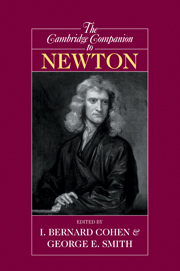Book contents
- Frontmatter
- Introduction
- 1 Newton's philosophical analysis of space and time
- 2 Newton's concepts of force and mass, with notes on the Laws of Motion
- 3 Curvature in Newton's dynamics
- 4 The methodology of the Principia
- 5 Newton's argument for universal gravitation
- 6 Newton and celestial mechanics
- 7 Newton's optics and atomism
- 8 Newton's metaphysics
- 9 Analysis and synthesis in Newton's mathematical work
- 10 Newton, active powers, and the mechanical philosophy
- 11 The background to Newton's chymistry
- 12 Newton's alchemy
- 13 Newton on prophecy and the Apocalypse
- 14 Newton and eighteenth-century Christianity
- 15 Newton versus Leibniz: from geometry to metaphysics
- 16 Newton and the Leibniz-Clarke correspondence
- Bibliography
- Index
13 - Newton on prophecy and the Apocalypse
Published online by Cambridge University Press: 28 May 2006
- Frontmatter
- Introduction
- 1 Newton's philosophical analysis of space and time
- 2 Newton's concepts of force and mass, with notes on the Laws of Motion
- 3 Curvature in Newton's dynamics
- 4 The methodology of the Principia
- 5 Newton's argument for universal gravitation
- 6 Newton and celestial mechanics
- 7 Newton's optics and atomism
- 8 Newton's metaphysics
- 9 Analysis and synthesis in Newton's mathematical work
- 10 Newton, active powers, and the mechanical philosophy
- 11 The background to Newton's chymistry
- 12 Newton's alchemy
- 13 Newton on prophecy and the Apocalypse
- 14 Newton and eighteenth-century Christianity
- 15 Newton versus Leibniz: from geometry to metaphysics
- 16 Newton and the Leibniz-Clarke correspondence
- Bibliography
- Index
Summary
THE INTELLECTUAL BACKGROUND OF A NATURAL PHILOSOPHER OF THE SEVENTEENTH CENTURY
Newton's theological manuscripts are concerned principally with two subjects: the interpretation of the prophecies of the Apocalypse and Daniel, and the history of the early Church. These two subjects are linked, but it was as a consequence of his interpretation of the Apocalypse that Newton undertook his study of the history of the Church. The study of prophetic literature was firmly rooted in Cambridge, where this subject was taught by Joseph Mede, author of a Clavis Apocalyptica (or Key to the Apocalypse), a work much used by Newton.
Newton’s interest in the prophecies is already documented in the “Quaestiones” of the Trinity Notebook (1664–5). In “Of Earth” (c. 1664) Newton made deductions about physics, “in rerum natura,” directly from the Scriptures: the final conflagration of the earth, and the probable succession of worlds. This last affirmation was supported by a passage of the Book of Revelation which referred to days and nights after the Last Judgment, which would have made no sense had the world finished for ever. In “Of the Creation” (c. 1664) Newton made use of a passage from Genesis to prove that God had created time. From these entries it is evident that Newton used biblical texts to determine the truth of a philosophical proposition. Strange or ingenuous as this approach of Newton’s might seem, given that the trial and condemnation of Galileo had shown the difficulty of reconciling philosophy and religion, it was one he maintained in subsequent years.
- Type
- Chapter
- Information
- The Cambridge Companion to Newton , pp. 387 - 408Publisher: Cambridge University PressPrint publication year: 2002
- 5
- Cited by



